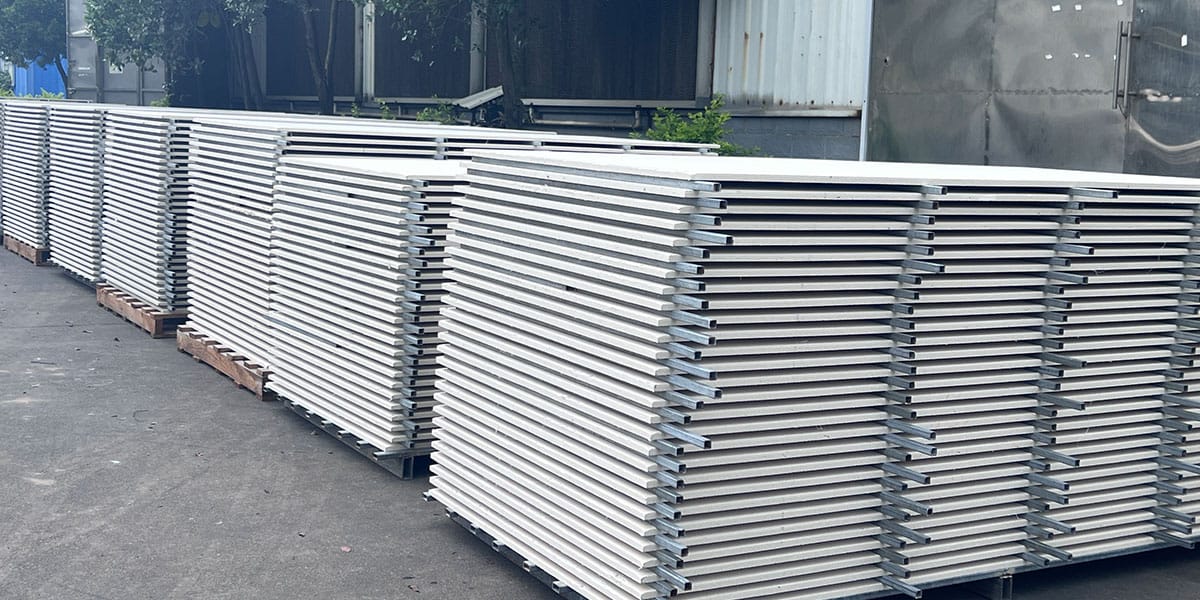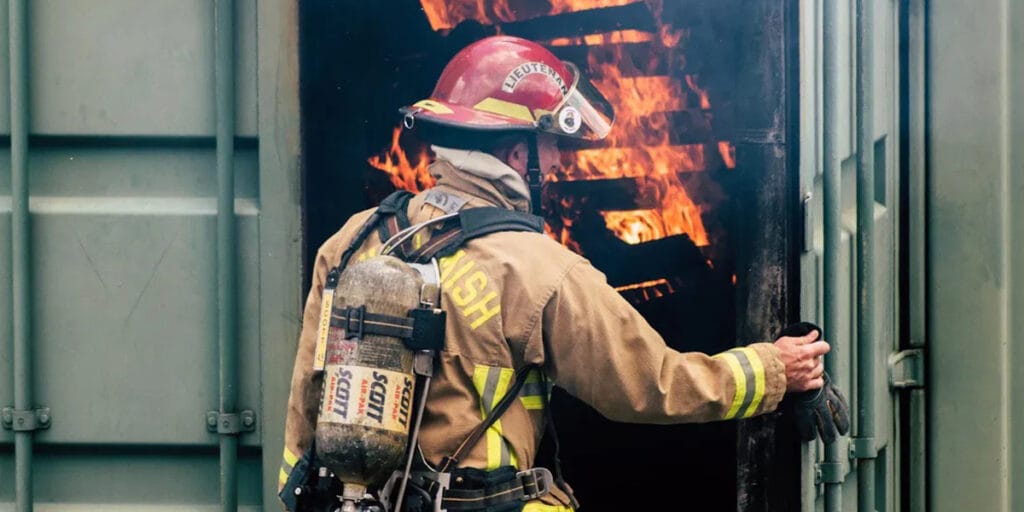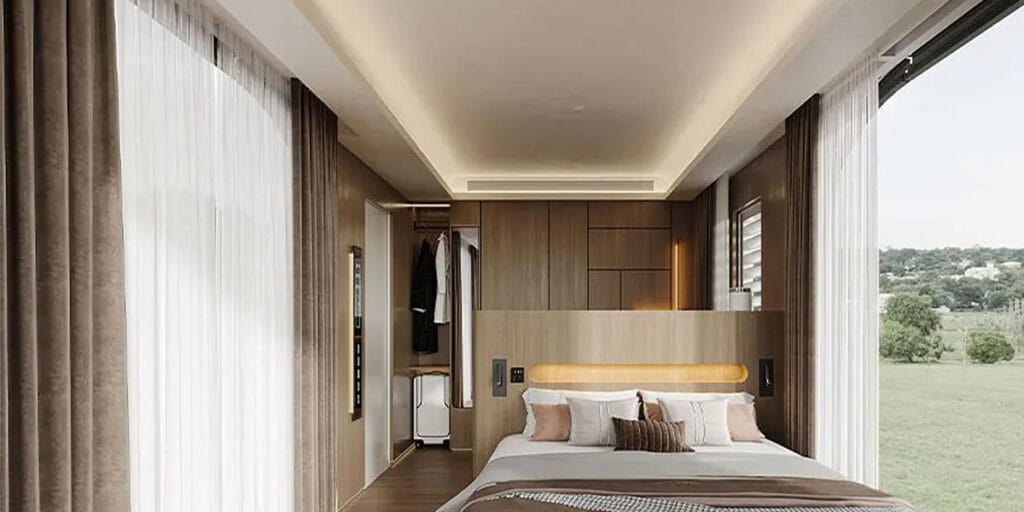
15 Jun Guide to Eco-Friendly and Fireproof Building Materials in 2025
Table of Contents
The demand for green and fireproof building materials is rapidly increasing. Issues like climate change and stricter safety regulations are driving the need for eco-friendly solutions. These materials not only benefit the environment but also ensure buildings are durable and safe.
In 2023, the market for fire-rated building materials was valued at approximately $35.4 billion. By 2032, it is projected to reach $53.2 billion, growing at an annual rate of 4.5% from 2024 to 2032. This growth is largely attributed to the implementation of more stringent safety standards.
Innovative materials such as chloride-free MgO board play a crucial role in protecting the environment while providing fire resistance. Jonathan O’Neill from the Fire Protection Association highlights that modern construction methods often incorporate more flammable materials, necessitating stricter regulations. Opting for green solutions like chloride-free MgO board contributes to a safer and cleaner world.
Key Takeaways
Green building materials help lower pollution and make construction better for the planet.
Fireproof materials keep buildings safe from fires and last longer.
Spending more on green materials now can save a lot later.
New materials like MgO boards and mycelium insulation are eco-friendly and resist fire well.
Using modern green materials in old buildings saves energy and keeps them safe while looking historic.
Key Benefits of Sustainable Building Materials
Environmental Impact and Carbon Footprint Reduction
Using sustainable materials helps lower construction’s harm to nature. Choosing eco-friendly options reduces carbon footprints and greenhouse gases. For example, special ready-mix concrete can cut CO2 emissions a lot.
Material Category | Industry Average (kgCO2e/m3) | Actual (kgCO2e/m3) | Reduction per Functional Unit (%) |
|---|---|---|---|
Ready-mix concrete, C60 | 442.96 | 344.7 | 22 |
Ready-mix concrete, C50 | 390.09 | 255.0 | 35 |
Ready-mix concrete, C40 | 355.83 | 262.4 | 26 |
Reinforcement steel | 0.62 | 0.50 | 19 |
These numbers show how green building helps the planet. Using low-carbon materials saves resources and supports eco-friendly construction.
Enhanced Fire Safety and Durability
Fireproof materials make buildings safer and last longer. Studies show advanced coatings and fireproofing improve strength in tough conditions. For example:
Study | Focus | Findings |
|---|---|---|
Kodur and Shakya | SFRMs | Showed how heat affects SFRMs, helping future research. |
Kang et al. | Structural members | Studied fire behavior using tested material properties. |
Zielecka et al. | Intumescent paints | Explained how these paints expand to resist fire. |
These studies prove fireproof materials are key for safe, green buildings. Adding them boosts safety and protects against climate risks.
Cost-Effectiveness and Long-Term Savings
Eco-friendly materials save money over time. A California report found spending 2% more upfront saves 10 times later.
Savings come from energy, water, and less maintenance.
The Bullitt Center recovers costs in 10 years with solar power.
The Tower at PNC Plaza cuts energy use by 30% with natural airflow.
These examples show green materials save money and help the planet. Investing in them means saving resources and cutting costs long-term.
Top Eco-Friendly and Fireproof Materials in 2025

Chloride-Free MgO Board
Chloride-free MgO board is a top eco-friendly, fireproof material. It can handle very high heat, protecting buildings from fires. This board resists temperatures up to 1,472°F (800°C) for four hours. Made from magnesium oxide, it does not burn, lowering fire risks.
New advances show why chloride-free MgO boards are important today. They pass ASTM E136-16A tests, proving safety at 750°C. These boards last a long time, making them great for green projects. Fewer replacements mean less waste and more durability.
Evidence Description | Details |
|---|---|
High fire resistance | MgO boards handle high heat without burning. |
Inherent fire resistance | Made from non-flammable magnesium oxide. |
Performance under extreme conditions | Withstands up to 1,472°F (800°C) and resists flames for 4 hours. |
Compliance with ASTM E136-16A test | Passed tests at 750°C, proving strong fire resistance. |
Choosing chloride-free MgO board helps create safer, greener buildings. Its fireproof and eco-friendly features make it a top choice.
Mycelium-Based Insulation
Mycelium-based insulation is a natural, sustainable option for buildings. Made from fungal roots, it keeps heat in and saves energy. Its production uses little energy and turns waste into useful material.
Studies back the benefits of mycelium insulation. Jones et al. (2020) found it cuts energy use while insulating well. Yang et al. (2017) showed its air-filled structure traps heat effectively. Xing et al. (2018) called it a good replacement for synthetic insulation.
Study Reference | Findings | Description |
|---|---|---|
Jones et al., 2020 | Mycelium composites are effective for insulation | Highlights the low-energy bio-fabrication and waste upcycling potential of mycelium composites. |
Yang et al., 2017 | Promising thermal conductivity | Discusses the thermal properties of mycelium due to air trapped in the material. |
Xing et al., 2018 | Alternative to synthetic materials | Classifies mycelium composites as viable substitutes for traditional insulation materials. |
Vašatko et al., 2022 | Enhanced mechanical properties | Explores how using forestry by-products improves the quality of mycelium composites. |
Mycelium insulation saves energy and supports eco-friendly goals. Its natural design makes it a standout material for 2025.
Wool Insulation
Wool insulation is a natural, high-performing choice for buildings. It uses less energy to make than glass fiber insulation. Wool felt breaks down naturally, adding nutrients back to the soil.
This insulation keeps indoor spaces comfortable year-round. It absorbs moisture, cooling in summer and warming in winter. Wool traps air in tiny pockets, stopping heat from escaping. Even when wet, it works better than synthetic materials.
Wool insulation needs less energy to produce than glass fiber.
It absorbs moisture, cooling in summer and warming in winter.
Wool traps air, stopping heat transfer and keeping spaces warm.
It stays effective even when wet, unlike synthetic options.
Wool grows back every year, making it a renewable resource.
Producing wool felt has a smaller environmental impact.
Wool insulation is biodegradable and compostable, reducing waste.
Using wool insulation means better performance and helping the planet. Its renewable and eco-friendly qualities make it a top pick.
Bamboo as a Renewable Resource
Bamboo is one of the most eco-friendly building materials. It grows very fast and regrows after being cut down. Unlike regular wood, bamboo matures in just 3–5 years. This means it can be harvested often without harming forests.
Bamboo helps the environment in many ways:
It absorbs carbon dioxide like trees, fighting climate change.
Its roots hold soil together, stopping erosion in deforested areas.
Bamboo needs little water and no harmful chemicals to grow.
Builders use bamboo for many purposes. It works for beams, roofs, floors, and walls. Special bamboo products are strong enough to replace steel or concrete.
Bamboo is light, making it easy to transport and cheaper to move. Studies show it costs less than wood or steel. Using bamboo saves money and supports green building practices.
Precast Concrete for Fire Resistance
Precast concrete is great for fireproof buildings. It is made in factories and brought to construction sites. This ensures it is strong and reliable. Its fireproof features make it safe for buildings.
Tests show precast concrete handles fire very well. For example, special concrete columns stayed strong after 240 minutes of fire exposure. This means buildings made with precast concrete can survive extreme heat.
Precast concrete also stops heat from spreading during fires. It stays strong even in high temperatures, making it perfect for fireproof designs.
Adding precast concrete to your building plans improves safety. It lasts a long time and needs little upkeep. This material is both safe and eco-friendly, offering great value.
AshCrete as a Sustainable Alternative
AshCrete is a green material that replaces cement with fly ash. Fly ash is leftover waste from burning coal. Using it in AshCrete reduces pollution and saves resources.
Instead of throwing fly ash into landfills, AshCrete turns it into something useful. It also uses less water to make, helping conserve this important resource.
AshCrete is as strong as regular concrete, sometimes even stronger. It lasts a long time and helps keep buildings energy-efficient by controlling indoor temperatures.
Choosing AshCrete means building in a way that helps the planet. It shows how waste can become valuable materials for a greener future.
Recycled Steel for Strong and Safe Buildings
Recycled steel is a strong and reliable building material. It works well in tough conditions like high winds, earthquakes, and fires. This strength means fewer repairs, saving time and money.
Steel homes are very durable and handle bad weather easily. Unlike wood, steel stays strong and needs less fixing over time. This makes it a better choice for long-lasting buildings.
High-Strength Low-Alloy (HSLA) steels are even better. They resist rust and are stronger than regular steel. Buildings made with HSLA steel last longer and need less care.
Recycled steel is also great for the environment. Reusing steel saves natural resources and cuts down on waste. Steel can be recycled over and over, making it eco-friendly.
Choosing recycled steel helps build safer, greener, and stronger buildings. Its durability and sustainability make it perfect for modern construction.
Hempcrete for Green and Cozy Homes
Hempcrete is a lightweight, eco-friendly material made from hemp and lime. It keeps buildings warm in winter and cool in summer. This reduces energy use and saves money.
Hempcrete also blocks noise, making homes quieter and more peaceful. It absorbs carbon dioxide, helping fight climate change. A hemp wall can store carbon, unlike cement walls that release it.
Hemp grows back quickly, in just one year. Making hempcrete uses less energy than making concrete. This lowers the carbon footprint of building projects.
Using hempcrete means choosing a material that is green and useful. It saves energy, traps carbon, and helps create sustainable homes.
Innovations in Sustainable Building Materials in 2025

Advanced Fireproof Coatings
Fireproof coatings are changing how buildings stay safe from fire. These coatings create a shield that blocks high heat and fire damage. They help buildings last longer and stay safer.
New improvements make fireproof coatings work even better. For example, coatings with a Limiting Oxygen Index (LOI) of about 30% meet the V-0 rating in the UL 94 test, which is a top fire safety standard. The table below shows important details:
Designation | Key Findings |
|---|---|
R1 | LOI near 30% earned V-0 rating in UL 94 test. |
R2 | FR compounds got V-0 rating with T@PSHRR under 499 °C and THR below 21 kJ/g. |
R3 | Non-halogenated FR compounds raised LOI with more char yield. |
R4 | Time to peak HRR over 210 seconds improved fire resistance. |
These coatings not only boost fire safety but also cut down on repairs. This makes them a smart and eco-friendly choice.
AI-Driven Material Optimization for Sustainability
Artificial intelligence (AI) is helping builders pick better materials. AI tools study data to find materials that are strong, affordable, and eco-friendly. This reduces waste and saves energy.
Here are some examples of AI in action:
Project Name | AI Use | Sustainability Benefit |
|---|---|---|
MIT’s AI Tool | Choosing Materials | Cuts cement use by 50% while keeping strength. |
EcoTower | Energy Use Modeling | |
GreenHome Initiative | Reducing Waste | Decreases construction waste by 25%. |
SmartCity Plaza | Managing Resources | Improves resource use. |
Using AI tools helps save money, energy, and materials. It’s a great way to build smarter and greener.
Carbon-Negative Concrete Technologies
Making concrete has always caused a lot of pollution. But carbon-negative concrete is changing that. This new type of concrete absorbs more carbon dioxide than it creates. It’s a cleaner choice for building.
For instance, U.S. roads could soak up 5.8 million tons of CO2 in 30 years. This would cancel out 5.5% of emissions from cement used in roads. Also, biochar-infused concrete can hold up to 23% of its weight in CO2 while staying as strong as regular cement.
Choosing carbon-negative concrete helps lower pollution and protect the planet. It’s a big step toward greener and more energy-efficient construction.
Smart Materials for Fire Detection and Prevention
Smart materials are changing fire safety with new technology. They help find fire risks early, giving time to act and stay safe.
These materials have smart sensors that improve fire detection. They watch for smoke, heat changes, and gas leaks carefully. This constant checking finds fire dangers early so you can act fast.
Smart sensors spot different fires, like chemical or electrical ones.
They lower false alarms by using data from many sensors.
Early alerts catch slow fires before they grow bigger.
Another cool tool is optical fiber temperature sensors. These work well in tough places like factories or risky areas. They find fire signs and use smart systems to tell real fires from safe conditions. This stops false alarms and gives correct alerts.
Optical fiber sensors connect easily to building systems.
They help people leave safely by showing where fires are.
They are strong and work well in hard conditions.
Smart materials also stop fires from spreading. Some coatings and fabrics don’t catch fire or put themselves out when flames touch them. This keeps damage small and people safer.
Adding smart materials to buildings makes them safer and lowers risks. These tools save lives and stop big damages. Choosing smart materials is a smart way to protect the future.
Practical Uses of Green and Fireproof Materials
Building Homes with Eco-Friendly Materials
Using green and fireproof materials in homes helps the planet and keeps people safe. These materials make houses strong, energy-saving, and protected from fires. Options like hempcrete, wool insulation, and bamboo keep homes warm or cool, cutting energy use and lowering bills.
A study of 28 eco-friendly home projects showed they can be affordable. These homes earned high environmental scores without costing more than regular ones. This proves that using green materials doesn’t have to be expensive, making them a good choice for families who want to build responsibly.
In areas with wildfires, fireproof materials can save lives and homes. For example, houses with fire-resistant walls, tempered glass windows, and metal roofs have survived fires. The table below shows real examples:
Example Home | Features | Result |
|---|---|---|
Malibu Mansion | Concrete walls, fireproof roof, tempered glass windows | Stayed safe during nearby wildfires |
Greg Chasen’s Home | Fire-rated walls, simple landscaping, tempered glass windows | Survived flames despite a burning car |
Jim and Nancy Evans’ Home | Metal roof, strong walls, stone perimeter | Stayed intact during the Palisades fire |
Choosing green and fireproof materials makes homes safer and better for the environment.
Fireproof Materials for Office Buildings
Office buildings need materials that meet fire safety rules and help the planet. Fireproof options like precast concrete, recycled steel, and special coatings keep buildings safe and strong during tough conditions.
Experts test these materials to make sure they work well. Groups like UL Solutions, with over 130 years of experience, check if they meet fire safety standards. The table below explains their role:
Testing Group | Features | Why It Matters |
|---|---|---|
UL Solutions | 130+ years of testing, fire safety checks | Ensures fireproof materials are reliable |
Using fireproof materials in office buildings lowers repair costs over time. For example, recycled steel is strong enough to handle storms and earthquakes. This strength means fewer repairs, saving money and resources.
Adding fireproof solutions to office buildings makes workplaces safer and cities greener.
Upgrading Old Buildings with Modern Materials
Fixing up old buildings with green and fireproof materials makes them better and safer. Switching to energy-saving appliances cuts power use and lowers bills. Sealing windows and doors stops air leaks, saving hundreds of dollars each year.
New plumbing systems also help. They use less water and energy, work better, and increase property value. The EPA says energy-saving plumbing can cut water use by 30%, showing how upgrades help both the planet and your wallet.
Historic buildings can stay true to their original look while adding green features. Careful updates keep their charm while making them eco-friendly.
Adding fireproof materials to old buildings boosts safety. Fire-rated walls, special coatings, and tempered glass windows protect them from fire damage. These changes make old buildings last longer and meet today’s safety rules.
Upgrading old buildings makes them safer, greener, and ready for the future.
Using eco-friendly and fireproof materials makes buildings safer and greener. These materials have many advantages:
Fire protection stops fires from spreading and causing damage.
Better insulation saves energy and lowers bills.
Choosing these materials helps earn green building awards and reduces pollution. Use them to build places that care for people and the Earth.
FAQ
What does eco-friendly mean for building materials?
Eco-friendly materials use recycled or renewable resources. They cut waste and need less energy to make. These materials also help the planet by lowering pollution.
Are fireproof materials fully fireproof?
No material can stop fire completely. Fireproof materials handle heat and slow fires down. They give extra time to stay safe during emergencies.
Do eco-friendly materials save money?
Yes, they do. These materials lower energy costs and need less fixing. Over time, they save money and help the environment.
How can I tell if a material is sustainable?
Check for labels like LEED or FSC. These show the material follows eco-friendly rules.
Are eco-friendly materials strong?
Yes, many are very strong. For example, bamboo and recycled steel last a long time and work well in tough weather.
